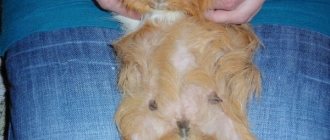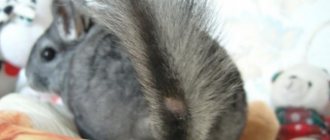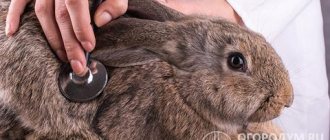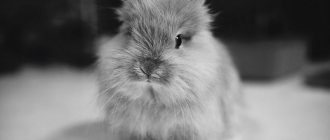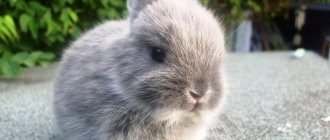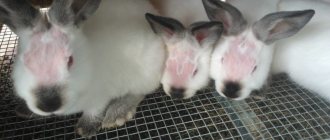November 9, 2018 Vladimir Khomyakov
Bald spots on the body
As you know, many breeds of rabbits are famous for their valuable fur. For the animal itself, it is a kind of protection from severe frosts, helps to squeeze safely and freely into narrow holes, and serves as camouflage when grazing. But a fur coat does not always look perfect. Not in terms of cleanliness, there are practically no problems here. Long-eared animals constantly clean themselves and even their fellow creatures, removing dirt and dead hairs.
I mean uniform coverage. If we leave natural shedding out of the equation, then the main causes of bald spots are insects - parasites, fungal infections, an unbalanced diet leading to a lack of microelements and vitamins, as well as stress and hormonal imbalances. Therefore, you and I need to respond in a timely manner to emerging baldness and correctly determine the cause of this phenomenon. And even prolonged molting should alert you. As you can see, the topic of conversation is very broad. Therefore, today I propose to narrow the topic and place a small emphasis on the appearance of bald patches behind the ears, without prejudice to other manifestations, of course.
Features of the fur behind the ears of a rabbit.
It should be noted that in most cases, it is from this area that baldness begins. Why, you ask? Because this is where it is most convenient for all evil spirits to hide. Firstly, rabbits practically do not reach this part of their body. By the way, have you ever wondered why all sorts of gels and ointments are applied there when protection against pests is necessary? That's right, to avoid licking them. Secondly, this area is often covered by lowered ears in a relaxed resting position, which means it is more comfortable to parasitize there. As a result, we have an analogue of the Achilles heel, but in the opposite part of the body.
You shouldn’t immediately sound the alarm at the slightest thinning of fur. The fact is that the body constitution of a rabbit, even with absolutely normal hair growth on the nape and neck, suggests some anomaly. Here are the so-called boundaries for changing the direction of their growth. They run along the lines: scruff - neck and neck - torso. In other words, the illusion of thinning is created, just like when artificially organizing a parting on our hairstyles. In rabbits, they arise naturally in places where the skin bends during head movement.
The scruff of the neck is a problem area even in healthy rabbits.
In addition, due to constant friction, even with the slightest shedding, hair loss occurs here. Be sure to pay attention to how the rabbit feeds from the bunker feeder and hay barn. Perhaps he is rubbing against some element of them. Of all the inhabitants of the cage, there may be only one such rabbit, but there may be several of them. The rest will all be more careful in this regard. How to distinguish the normal condition of the coat and skin from the affected ones?
Description
When you notice bald spots on a rabbit's fur, it is important to determine whether this condition is dangerous for the pet. For this, an urgent visit to a veterinarian is required. After examination, collecting tests and receiving their results, the doctor will find the answer to this question and prescribe the appropriate treatment.
A general and biochemical blood test will determine which organ is suffering, whether there is an inflammatory process in the body, and whether there is a lack of vitamins and nutrients.
Scraping the bald area will help identify fungal or bacterial growth in the area.
Molting and rabbit are inseparable concepts.
In general, molting in a rabbit is a common occurrence. Babies under 3 months, roughly speaking, do not emerge from the state of changing furry coat. Next, spring and autumn molts are recorded. Just like the hare, which “forcedly” adapts, either to the gray land or to the white snow. But rabbits do not have such a clear fixation on time and duration. Therefore, you should not worry if the fur suddenly starts to come out, for example, in the middle of summer.
Do not think that shedding is necessarily accompanied by obvious bald spots. On the contrary, in a number of cases the process of replacing old hairs with new ones occurs smoothly. Only local thinning and traces of hair in the cage can lead us to the idea that it’s time to pick up a comb and remove everything unnecessary from the rabbit. After all, he can easily swallow a hairball while combing it out on his own. (And he will definitely do this.)
Shedding does not always expose the skin completely.
Of course, when shedding, bare areas are very likely. However, on these ragged bald patches you can see new growth already emerging. At the very least, they should appear there in a day or two. In a month or even earlier, not a trace of the former defect will remain. The reasons for prolonged molting are: heat, high humidity, prolonged stress, unbalanced diet.
But if this does not happen and bare skin is visible for a long time, like on a knee, it’s time to sound the alarm. Often, pimples, redness, scratching, peeling, and sometimes movement of scales or the parasites themselves are visible on the surface. In addition to insects, there are other reasons for hair loss, which we will discuss at the end of the article.
ON THE SKIN OF light-colored rabbit breeds, new growth is clearly visible. If it is dark in color, small hairs may not be noticeable. Their presence is indicated by a bluish tint to the problem area.
It is important to make sure that this is truly a natural shedding, and not a forced loss of cover due to ectoparasites. The last word combines into one group all parasites living on the surface of the body: lice (pediculosis), fleas, ear mites (otodectosis), fur mites (cheiletiosis), cutaneous or subcutaneous mites (psorptosis), fungi or lichen (microsporia).
Bald patches caused by lice and fleas.
These small parasitic insects “love” to settle on animals with thick fur. Rabbits, especially when kept in large numbers, are all the more at risk. Adult rabbits are the first to become infected, and from them the rest of the small population. Lice and fleas themselves do not feed on hair and do not damage the hair roots. However, they love to drink blood and secrete saliva to prevent it from clotting. This, in turn, causes severe itching and forces our rabbits to work with their paws, rubbing against everything they can. These are walls and nets and feeders... As a result, we have damage to the skin, and therefore to the hair follicles.
In passing, I will note, since this is very important, that baldness is not the worst thing that can be associated with fleas and lice. They are carriers of smaller parasites - various types of ticks and microbes.
MYXOMATOSIS VIRUS is transmitted by a flea through saliva, similar to a mosquito. Therefore, even if the farm is kept in a room equipped with means of exterminating flying bloodsuckers, rabbits can be infected with this dangerous disease.
If measures are not taken, lice and fleas can severely depress animals, which will affect their growth schedule. In severely neglected farms, deaths from anemia and exhaustion are even recorded. It is important to localize and neutralize such uninvited guests at an early stage. And the signal of their appearance is hair loss and baldness, primarily behind the ears. Unlike ticks, lice and fleas are clearly visible even to the naked eye. Still, their size, as well as the size of their nits (eggs), reaches 1 mm or even more. They can be seen closer to the roots of the hair.
Nervous abnormalities
When keeping rabbits, certain conditions must be observed. These animals are very sensitive to noise, pain, and contact of skin and ears with water.
Nervous pathologies are quite common among rabbits, which can cause baldness. For example, often on farms, pets begin to pluck each other’s fur. The reasons for the violation are related to:
- High density in the cage, which provokes nervous behavior in animals. The rabbits should be temporarily removed and behavior changes observed.
- Lack of walking causes individuals to tend to pluck.
- Aggressive behavior of males.
- Stress – hair loss can be a result of moving, noise, vaccination.
How to get rid of lice and fleas?
There are numerous medications on sale in pet stores that can rid a rabbit of fleas in the shortest possible time. These products include drops, solutions and shampoos. For example, “Frontline”, “Advantage” drops, and the drug “Neguvon” are widely used. Medicines that are used in the form of sprays are also prescribed. For treatment, this product is sprayed at a distance of 30 cm from the rabbit’s withers, at the rate of 1 spray per 1 kg of live weight. They are more often used by owners of domestic decorative rabbits. Often such sprays and shampoos are quite aggressive (the same “Advantage”) and they are prohibited from being used on commercial animals used for meat. Therefore, read the instructions carefully. There may also be restrictions on the weight and age of the rabbit.
You can also use a special collar as a means of combating fleas, but you must take into account the fact that toxic substances are used in its production process. The collar can demonstrate its effectiveness during a walk. In this case, it is able to scare off new parasites, but it is recommended to remove it immediately upon returning from a walk. I advise you to watch the video about preventive protection of rabbits, if you have not already watched it in the article on the fight against worms.
In industrial rabbit breeding, they often resort to the help of universal products “Ivermec” or “Ivermectin-10”. These medications contain ivermectin as an active ingredient. They are very effective against all types of parasites, both cutaneous and downy, and internal (helminths, according to my information. These drugs have prescribed hazard classes and, accordingly, terms of removal from the body.
EACH SPECIES of animals are parasitized by their own types of ticks and fleas. However, when several species of animals are raised together, skin parasites jump around without distinguishing their identity. Often chicken or dog fleas can be found on a rabbit. This is not dangerous. In extreme cases, they may bite a couple of times, but they will not “drill” passages and lay eggs. Although, as we know, even through a bite, the microbes of an infected insect can enter the rabbit’s blood. In general, it is necessary to combat small parasites throughout the entire farm.
Infectious diseases that cause paw damage
Listeriosis in rabbits
One of the reasons why a rabbit's hind legs failed is listeriosis. This is an infectious disease of bacterial origin that affects the mammary glands, nervous and genitourinary systems. Most often, young animals and pregnant female rabbits are affected. Goats, sheep, pigs, cattle, poultry and people can get sick.
Sources of infection
- Sick or recovered rabbits (long-term carriage, up to 2.5 months).
- Rodents (rats and mice).
- Wild animals (foxes, hares and others).
- Insects (lice, fleas, ticks, gadfly larvae).
- Man (as a mechanical carrier).
Infection can occur through contact with sick animals, through nutrition (contaminated feed and bedding), through damaged skin and mucous membranes.
Manifestation of the disease
The disease can occur in hyperacute, acute, subacute, chronic (latent) and atypical forms. Manifested by the death of pregnant rabbits (immediately after or before childbirth), abortion during pregnancy, mummification (drying out) and decomposition of fetuses, mastitis, metritis and endometritis (inflammation of the uterus), death of the entire litter after childbirth, brown vaginal discharge, paresis or paralysis of the hind legs. limbs in rabbits. Rabbits lose weight, eat poorly or refuse food altogether, and their fur becomes disheveled and dull.
With an atypical form of the course, the clinical picture may be similar to a false pregnancy. In such a situation, the rabbits die while they are still embryos, and the female rabbit cannot become pregnant and give birth. Other signs of the disease may be absent, although the animal remains a carrier of the pathogen.
Treatment
Carrying out therapeutic measures in rabbit farms is economically unjustified. Even if recovered, animals remain carriers and will be infertile, and there is also a risk of infection in humans. Sick rabbits are killed, the rest are vaccinated. Meat can be eaten, but only after long-term boiling (at least two hours). The skins are disinfected.
For the treatment of decorative rabbits, antibiotics ("biomycin", "tetracycline" and others), immunostimulants ("roncoleukin"), stimulants of metabolic processes ("catozal", "gamavit", "mikrovitam"), homeopathic drugs ("traumeel", " Engistol", "Echinacea compositum").
If there are signs of damage to the nervous system, the therapy described above (treatment of listeriosis) is used.
Prevention
For prevention it is necessary:
- Examination and quarantine of incoming animals.
- Control of insects and rodents (disinsection and deratization).
- Control and purchase of feed only from reliable and prosperous farms.
- If there is a threat of infection, vaccination is carried out (with a vaccine from the AUF strain).
Encephalozoonosis of rabbits
The disease is caused by intracellular parasites of the protozoan class, manifested by damage to the nervous system, as well as the kidneys and other internal organs (liver, spleen, heart, eyes, intestines). Infection occurs through the nutritional route, the pathogen is excreted in urine, feces, and a transplacental (intrauterine) method of infection is also possible.
Symptoms
Pathology can manifest itself:
- Loss of coordination and torticollis.
- The pupillary reflex may be absent.
- Movement of the animal in a circle.
- Paresis, paralysis and atrophy of the muscles of the limbs.
- Development of uveitis (inflammation of the eye vessels) and lens opacity.
A feature of the pathology is that in most animals the disease occurs as a carrier and begins to manifest itself only when exposed to factors that weaken the immune system. An accurate diagnosis is made only based on the results of laboratory diagnostics.
Treatment
- To influence the pathogen, “albendazole” and “fenbendazole” are used.
- For anti-inflammatory action, the following are used: “traumeel”, “dexamethasone” or “dexafort”.
- To stimulate metabolic processes, “catozal”, “gamavit” or “microvitam” are used.
- For stimulation and restoration of the nervous system: “Cerebrum compositum”, “Proserin” and others.
- If kidney function is impaired: “cantharis compositum”, “cantaren”, “solidago compositum” and others.
- In case of eye damage, eye ointments based on hydrocortisone or antibiotics (“tetracycline”) are used.
- Treatment should be carried out as prescribed and under the supervision of a veterinarian.
Prevention
- Timely disinfection.
- Prevention of weakening and support of immunity in animals (high-quality feeding, absence of stress, drafts, hypothermia).
Ticks on a rabbit's body.
There is a specialization among these rabbit enemies. Some species prefer to settle on the auricles and climb into the ear canals, others settle in other parts of the body, and still others feed exclusively on wool. But the essence of this difference for rabbits, and therefore for us, does not change much, nor does the result itself. We see and are upset when, along with loss or thinning of the fur, there is dandruff, redness, scratching from severe itching and traces of blood, as a result.
Dandruff, redness and pimples are clearly visible.
But since today we are talking more about bald patches in the nape area, it is worth pointing out that it is the subcutaneous mite that most often begins to parasitize from here. But, for example, the fur parasite “climbs” from the tail and therefore we see the first baldness in the area of the back and rump. As for the otodectosis ear mite, it parasitizes between the ears, on the crown and back of the head. This process of settlement occurs after final colonization in the ear opening and on the auricles. So to speak, it opens up to wide open spaces.
Stress
Even animals suffer from nervous shocks. For what reason can a hairless rabbit appear in a rabbitry? Feedback from farmers confirms that a sudden loss of hair in an animal can also result from a stressful situation. In addition, in cramped conditions, animals can simply eat each other’s fur. This is all explained by an overly nervous atmosphere resulting from crowded content. Some farmers believe that this behavior of animals is associated with boredom. It is difficult to say how true this is. However, it has been established that animals living in a free enclosure lose their fur less often.
Measures to prevent and get rid of ticks.
At the initial stage, you can get rid of ticks using special sprays, such as Psoroptol or Acaromectin. If the disease has already gone far, then more effective (acaricidal) drugs are used, like the above-mentioned “Ivermek” and “Otodectin”, as well as antibiotics and anti-inflammatory drugs. Treatment methods and medications used are determined by a veterinarian based on special laboratory tests. Unfortunately, if fistulas, large ulcers, or general blood poisoning appear, you will not be able to cope on your own. Therefore, at the slightest suspicion of the presence of these small and biting parasites, take measures to exterminate them.
Always keep in mind the possibility of massive parasite infestation. Do not allow overcrowding of cages, place new rabbits in quarantine, carry out disinsection more often, including other utility rooms, and the surrounding area. Fight against rodents, wild and stray animals. If there are other species of animals nearby, everything said applies to them in full. When stocking up on hay for the next winter, try to correctly calculate its quantity so that it does not remain in storage for a long time. It is old hay that often becomes a refuge for all sorts of diseases and insects - parasites.
Treatment
Treatment for baldness is prescribed by a veterinarian after diagnosing and identifying the cause of this condition:
- For fungal infections, antifungal agents are used. If the cause is bacterial growth, antibiotic therapy is indicated.
- Vitamin deficiency can be controlled with vitamin therapy and normalization of the diet.
- When infected with parasites, they are destroyed.
- In case of hormonal disorders, the hormonal levels are brought back to normal.
- If the animal has been exposed to a stressful situation, they provide auxiliary effects for the body with the help of vitamins and provide a calm environment.
Dermatomycosis or fungal infections of the rabbit's skin.
ATTENTION! A fungal disease, ringworm can be transmitted from rabbits to humans. If you suspect an animal has a fungus, take safety measures for yourself and notify all people who come into contact with rabbits about the danger. Carry out all housekeeping work wearing rubber medical gloves. Contact your veterinarian as soon as possible and confirm or refute the suspicion using special tests. If necessary, begin treatment immediately.
Next, let's talk about ringworms. It is this species that mainly “sticks” to rabbits, although there are about a dozen different types of skin fungi. Dermatomycosis can be caused by both their small-spored representative (microsporia) and trichophyton (trichopytosis). For us, the difference between these parasites is not particularly important. Manifestations and treatment are no different, except that the latter also affects the rabbit’s claws.
Ringworm is characterized by rounded borders, round spots are visible.
Practice shows that in most cases, stray cats are carriers of the fungus. By stroking such an animal, you will almost certainly leave unfortunate spores on your palm, which, with further communication with rabbits, will settle on them. When walking eared dogs along the street, you also need to make sure that they do not come into contact with homeless four-legged street children. To guarantee safety, special collars, gels, and vaccinations are used.
A Wood's lamp can be used to confirm the presence of lichen.
RINGLISH is identified in the laboratory using a Wood's lamp. It emits a long-wave ultraviolet spectrum invisible to us, which, when it hits areas infected with a fungus, causes its waste products to glow greenish. For a more accurate diagnosis, a culture similar to a bacterial culture may be prescribed. But it takes at least 10 days.
This is how the spores of the fungus and its metabolic products glow.
The word “cutting” itself carries basic information about the results of infection. We see round or irregularly shaped bald patches on the rabbit's body. In this case, animals feel severe itching, since not only the hair and its roots are affected, but also the nerve endings. It is clear that a rabbit will not die from bald patches or even from itching, but its life can become so unbearable that growth will slow down or completely stop. A weakened immune system will open up gaps for other dangerous diseases, and the fungus itself can spread to the entire farm, including the rabbit breeder himself.
Fungal treatment specialist advice:
For treatment, use the drug "Surolan". It simultaneously acts against itching that occurs due to secondary infections. "Surolan" also prevents skin irritation. It is important to shake the solution well before use. Apply 1-2 drops to a cotton swab and anoint the affected areas. Never touch the fireplace with your bare hands. Instead of Surolan, you can use Fenistil, Antimycotin, Miconazole, Ketoconazole, Sanoderm, Saprosan, Unisan, Imaverol. The list is very large, the main thing is to follow the attached instructions. However, beware of buying ointments from human pharmacies. The fact is that rabbits simply lick off the ointments, mistaking them for dirt, and clean their bodies. This way they can get poisoned. Ointments from veterinary medicine were specially created for animals, taking into account possible licking.
IF YOUR FIRST KIT does not contain ointments for ringworm, do not waste time and use regular iodine. Lubricate the affected areas at least 2 times a day (morning and evening). This alone will suppress the parasite, and in some cases will reduce the outbreaks. At one time I even managed to completely cope with lichen in a week. True, it was on one rabbit in the initial stage, and did not have many lesions. I lubricated them with a cotton swab almost every 4 hours.
If your farm is quite large, say 50 heads or more, or it is located near other farms, or close to a large livestock farm, it makes sense to vaccinate rabbits against ringworm using the drug "Vakderm". Then your pets will probably be safe for the whole year. And so, the risk is quite high. And of course, no one canceled the planned general cleaning of the cells and the surrounding area with burning and chemical treatment. It goes without saying that we must constantly fight against the carriers of dangerous diseases - rodents.
IN SEVERE DAMAGE, care should be taken to reduce the load on the liver and increase metabolism (metabolism and removal of harmful substances from the body). Add hepcarnitol to the water, 1.0 ml per 0.5 liter of water and drink it for ten days. You can also use Carniton. To speed up recovery and regeneration of the skin, you can subcutaneously inject a course of “Ribotan” 3 injections, repeating after 3 days.
Consequences of urinary dermatitis.
When the cages are contaminated, rabbits rub against structural elements and are affected by aggressive chemical substances that are formed during the decomposition of urine and feces or their direct impact (sticking after defecation). Here, the paws and back of the body, genital areas are most often affected, but manifestations behind the ears are not excluded. You may ask, how can this be, since rabbits are extremely clean?
| Subscribe to our website's weekly newsletters: ✦ BROTHER RABBIT ✦ Current notes on keeping rabbits are waiting for you. SUBSCRIBE |
That’s how it is, but there are force majeure circumstances. For example, bladder problems (urinary incontinence), gastrointestinal disorders (diarrhea) or coccidiosis, poor motor skills or complete paralysis of the limbs, general loss of activity due to some illness. Inspect such an animal more often, wash away dirt with baby soap. To relieve inflammation, use Aloe Vera gel and fight flies that can lay larvae at the affected areas. If the measures taken are ineffective, you notice depression in your pet and even an increase in temperature, contact the clinic to prescribe an antibiotic.
Vitamin deficiency and lack of certain microelements.
For normal hair growth, a rabbit needs a whole set of organic compounds that the body cannot synthesize on its own. Only from the outside. The presence of vitamins A, E, B12, and PP (nicotinic acid) in feed is very important. To supply them to the body, it is necessary that the animals eat plenty of grass along with seeds, bran, grain, fruits and vegetables. Bone meal is needed as a supplement. It contains the necessary building material - calcium, as well as sulfur, which promotes the synthesis of new cells. Therefore, with a deficiency of the latter, slow baldness occurs. During the suckling period, the amount of vitamins received depends on the quality of the mother's milk. This, in turn, is in direct connection with the nurse’s diet. Further, when feeding on their own, the rabbits cannot immediately switch to a complete balanced feed, so they may not receive enough vitamins.
All of the above also applies to adult rabbits. Any competent veterinarian, when examining a rabbit with prolonged shedding and bald spots, will give recommendations on vitamin therapy. In advanced cases, as they say, it is already too late to drink Borjomi. Carrots or fish oil alone will not fix the problem. It is necessary to immediately use complex vitamin preparations as additives to feed: “Gamavit”, “Ushastik”, “Chiktonik”, “Rex Vital amino acids” and others.
Hormonal imbalance
What to do if a hairless rabbit appears in the rabbitry? Perhaps the problem is a hormonal imbalance. Such a diagnosis can only be made by an experienced veterinarian, based on the results of blood tests of the animal. The cause of the disease, as a rule, lies in a lack of vitamins K and E. As a therapeutic therapy, the doctor usually prescribes hormonal drugs that help normalize the background. The diet of rabbits should also be reconsidered.
Swelling on the body of animals can appear due to purulent inflammation of tissues, cysts, old scars and scars. Perhaps these formations are associated with cancer. If such symptoms are detected, you should definitely show the animal to a veterinarian. Based on the results of the examination, the doctor will be able to prescribe treatment.
Other causes of baldness.
Abnormal hair loss. Possibly hormonal imbalance or the presence of parasites.
There are other, less common causes of what we call rabbit baldness.
Bedsores are the companions of obese, aged and inactive animals. The latter circumstance may be the result of some kind of disease, for example, paralysis of the hind legs or paraplegia. (Simultaneous paralysis of the front and hind legs.)
Rabbit syphilis or spirochetosis at an early stage affects only the areas around the anus. It is distinguished from other types of baldness by swelling and obvious redness of the skin surfaces in the genital area.
Hormonal imbalance (imbalance) is rare and can only be determined in a veterinary laboratory after a blood test.
Genetics. Rabbits may be born whose hair does not grow at all or all falls out during the first molt.
Reaction to medications.
Mechanical damage (fights, abrasions, hair plucking by rabbits - barbers).
Dear friend, in conclusion, let’s summarize what has been said. There are many reasons for focal hair loss in a rabbit. I hope that this article will give you the opportunity to identify the disease as quickly as possible and begin its treatment. This will not only make your pet’s existence easier, create normal living conditions, but will also prevent the disease from growing and spreading among its relatives. It is very important to make a correct diagnosis and not start, for example, treating lichen or bedsores with a remedy against skin parasites. But, you see, the manifestations in all cases are very similar.
Always check for microsporia using a Wood's lamp. Pay attention to details such as flaking or dandruff. It appears as a result of the activity of all types of mites. In addition, their fur appearance can be visually distinguished on the body of light-colored rabbits due to the contrast. On colored breeds it manifests itself through the so-called “walking dandruff”. It seems to move, being moved by insects. Hair loss in areas of diaper rash with bedsores is rapid. The vegetation falls out in large clumps, leaving reddened, inflamed areas on the body.
Do not allow parasites to run rampant for a long time, as bald spots, scratches, rashes, redness, and pimples will be replaced by fistulas and ulcers. Lethargy, depression, anemia and inflammation of fairly large areas with an increase in overall body temperature and even blood poisoning are likely. And this endangers the very life of the rabbit. And treatment will be more expensive, with the use of antibiotics, healing ointments and gels, and special vitamin therapy. Good luck!
Please share this article with your friends on social networks:
Please rate the article. Ask a question, discuss on the forum.
Injuries
Causes
One of the common reasons for a rabbit losing its hind legs is a spinal injury. Rabbits are quite fragile animals, so the cause of this condition can be: careless handling (strong compression during fixation, etc.), a fall from a height (for example, a decorative rabbit falling from a table or other elevated surface), a slippery floor, and others.
In addition, the cause of paw injury in a rabbit can be:
- Severe fright (a loud sound or another animal can cause the animal to jerk sharply to the side, causing displacement and pinching in the spine; the animal can also be injured by hitting a wall or some object).
- A protruding sharp object (the paws can be injured by any sharp objects in the cage, these can be nails, wire, etc., and subsequently an abscess may form at the site of the injury).
- If the rabbits are overcrowded, fights may occur, which can also result in spinal injuries and broken paws.
- Also, the reason that the rabbit’s hind legs have failed, the animal has received some other injury and severe stress, may be improper transportation (loud noises during transportation, strong shaking, etc.).
- Improper feeding (with a lack of calcium in the diet, bones will become more fragile, the risk of limb fractures and spinal injuries will increase).
Treatment
The provision of medical care depends on the type of injury:
- For minor injuries (shallow small wounds), you can help yourself - rinse with a solution of furatsilin and apply a bandage with ointment (levosin or levomikol, they contain an antibiotic that is not dangerous for rabbits - levomycetin, they relieve pain and promote healing).
- For more serious injuries (deep wounds, wounds with a large area of damage, suspected fracture of the paw), especially in a situation where the rabbit has lost its hind legs, it is necessary to urgently seek the help of a specialist.
- In the case of a wound, in addition to treatment, surgical intervention may be required (suturing, antibiotic-novocaine blockade, and others). After a course of antibiotic therapy, it is necessary to use probiotics (Vetom and others) to restore the intestinal microflora.
- If a fracture or spinal injury is suspected, an X-ray examination is necessary. In case of fractures, a fixing bandage is applied, to restore innervation in case of spinal injuries, the following are used: “proserin” (the dose is selected individually and very carefully), “catozal” (stimulates metabolic processes and the activity of the nervous system, as well as the exchange of calcium and phosphorus), “traumeel”, “cel t”, “cerebrum compositum” and others.
Prevention
To prevent injuries, it is necessary to comply with the rules for keeping and transporting the animal, proper feeding (balanced diet), protection from stress, and careful handling.
